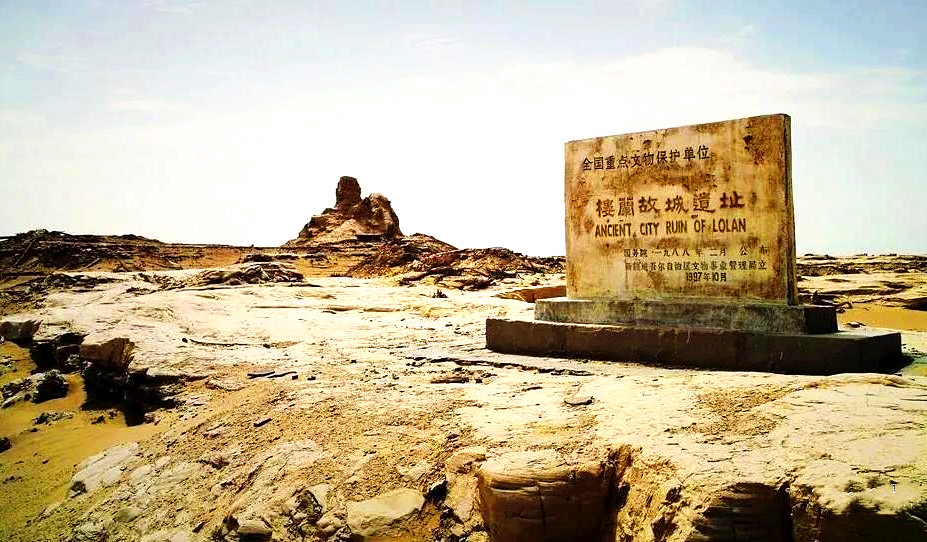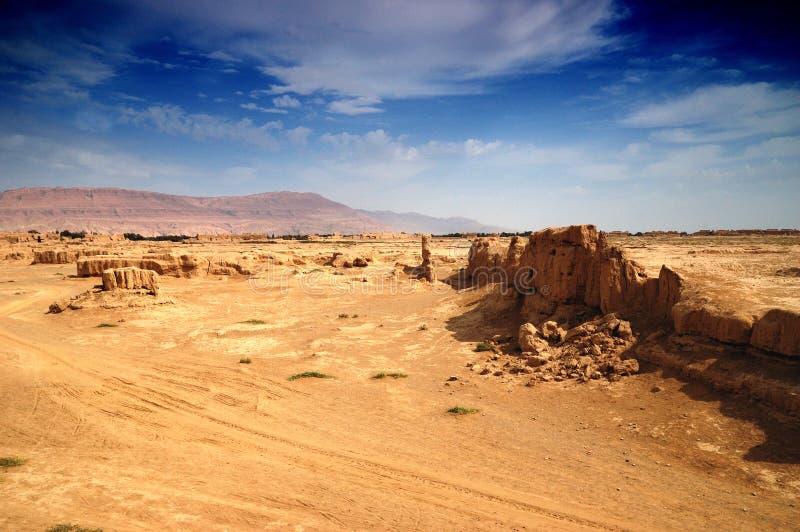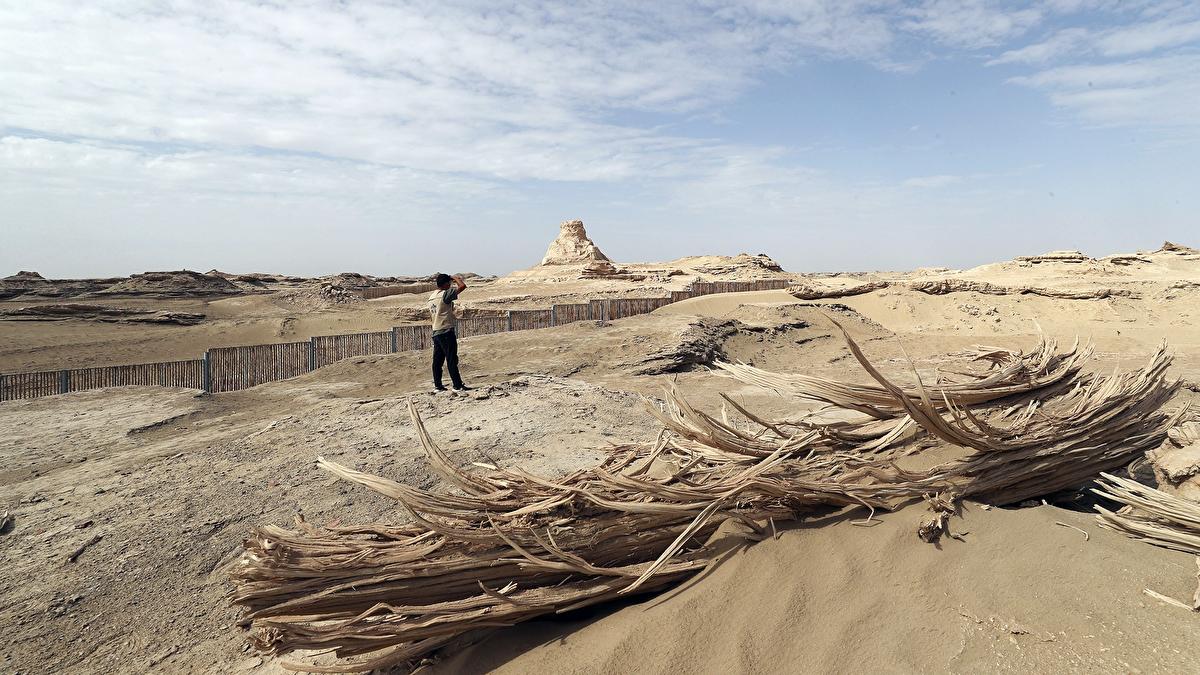Exploring Loulan Ancient City: The Enigmatic Ruins of the Silk Road

An Essential Guide to Visiting Loulan Ancient City
Nestled within the arid expanse of the Xinjiang Uygur Autonomous Region, the Ancient City of Loulan stands as a testament to a bygone era, whispering tales of the Silk Road’s rich history. Once a thriving oasis that flourished amidst the harsh desert sands, Loulan now lies in ruins, captivating the imagination of travelers and historians alike. As you traverse the remnants of this once-prosperous city, you’ll uncover the secrets of its enigmatic past, where diverse cultures converged, and the spice-scented caravans exchanged goods, ideas, and stories.
Visiting Loulan is more than just an exploration of ancient ruins; it’s a journey through time, where each crumbling wall and wind-swept pathway carries the echoes of long-lost civilizations. The nearby museum provides a modern contrast, showcasing artifacts that illuminate the region’s fascinating history and cultural heritage. With a backdrop of stunning desert landscapes and a sense of mystique that envelops the area, Loulan beckons adventurers, history enthusiasts, and those seeking unique experiences off the beaten path. Prepare yourself for an unforgettable expedition into the heart of one of China’s most storied locations, where every step tells a story of resilience and transformation amidst the sands of time.
In This Guide
- An Essential Guide to Visiting Loulan Ancient City
- The Rich History and Legends of Loulan Ancient City
- Main Highlights: What You Absolutely Can’t Miss
- Planning Your Visit: A Practical Guide
- Tickets: Prices, Booking, and Tips
- How to Get There: A Complete Transportation Guide
- Local Cuisine and Accommodation Nearby
- Frequently Asked Questions
- Final Thoughts on Your Trip
The Rich History and Legends of Loulan Ancient City
Nestled deep in the heart of the Xinjiang region of China, Loulan Ancient City, or Loulan Gu Cheng, has long captivated the imaginations of historians and travelers alike. Once a thriving hub along the fabled Silk Road, this ancient city is steeped in rich history and legends that date back over two millennia.
Founded in the 2nd century BC, Loulan was strategically positioned near the Lop Nur salt lake, which facilitated trade and cultural exchange between the East and West. The city thrived as a bustling trading post, serving as a vital link for merchants and travelers traversing the harsh terrains of the Taklamakan Desert. It became renowned for its vibrant marketplace, where silk, spices, and precious stones were exchanged, weaving a tapestry of cultural interactions that shaped the regions surrounding it.
Despite its prosperity, the fate of Loulan took a dramatic turn. By the 4th century AD, the city began to decline due to changing trade routes and environmental factors, including desertification that altered the landscape. Irrevocably abandoned by the 8th century, Loulan faded into obscurity, becoming a mere whisper in the annals of history. However, its rediscovery in the early 20th century by explorers like Aurel Stein and others sparked a renewed interest in its enigmatic past.
Legends surrounding Loulan are as intriguing as its history. The city is often associated with tales of the “Loulan Beauty,” a well-preserved mummy discovered in the region, believed to represent the ancient inhabitants of the area. This captivating figure, along with other archaeological finds, hints at the diverse cultural influences that permeated Loulan, including connections to ancient Persia and the Greco-Roman world. The stories of these ancient peoples continue to resonate, painting a picture of a rich, intercultural exchange that defined this remarkable city.
Visitors today can explore the remnants of Loulan, which include crumbling walls and scattered artifacts that evoke the spirit of a once-thriving civilization. The nearby museum offers a glimpse into the lives of those who walked the streets of Loulan, showcasing artifacts that tell stories of trade, daily life, and the city’s eventual decline. Travelers are encouraged to prepare for their journey to Loulan by bringing water, warm clothing, and a sense of adventure, as the region’s unique and challenging environment invites exploration and intrigue.
In essence, Loulan Ancient City stands not only as a testament to the Silk Road’s historical significance but also as a beacon of the human spirit’s quest for connection and discovery. Its rich tapestry of history and legend invites travelers to step back in time and experience the echoes of a civilization that once flourished in the desert sands.

Loulan Ancient City.
Main Highlights: What You Absolutely Can’t Miss
The Ancient City of Loulan, a captivating relic of the Silk Road, invites travelers into a world steeped in history and mystery. Here are the main highlights you absolutely cannot miss during your visit:
1. The Ruins of Loulan
Wander through the remarkable ruins of Loulan, which date back to the Han Dynasty. These remnants of an ancient oasis city provide a glimpse into the past, showcasing the architecture and urban planning typical of Silk Road settlements. As you explore, imagine the bustling trade that once flourished here, connecting East and West.
2. Loulan Museum
A visit to the Loulan Museum is essential for anyone eager to understand the history of this ancient city. The museum houses a rich collection of artifacts, including textiles, pottery, and mummies, all of which narrate the story of Loulan’s inhabitants and their interactions along the Silk Road. The building itself, with its striking Egyptian-like exterior, is a modern architectural gem amidst the historical landscape.
3. Local Market Experience
Immerse yourself in the local culture by visiting the nearby market. Here, you can find fresh produce, local handicrafts, and perhaps some delightful snacks. Engaging with the locals and sampling their wares will enrich your experience, providing a taste of daily life in this remote region.
4. Stunning Desert Landscapes
The surrounding landscapes of the Taklamakan Desert are breathtaking. As you traverse the area, take time to appreciate the stark beauty of the desert, with its vast dunes and unique rock formations. This dramatic backdrop adds an otherworldly quality to your journey, making it an excellent opportunity for photography enthusiasts.
5. Cultural Insights
Loulan is more than just ruins; it’s a gateway to understanding the Silk Road’s diverse cultures. Look for opportunities to engage with local Uyghur communities and learn about their traditions, music, and cuisine. Such interactions can provide deeper insights into the historical significance of Loulan as a melting pot of different civilizations.
6. Preparation Tips
Given the remoteness of Loulan and the harsh desert conditions, preparation is key. Ensure you pack plenty of water, sun protection, and warm clothing for the evenings. Be mentally prepared for the challenges of desert travel, as this will enhance your overall experience.
7. Sunset Views
Don’t miss the chance to witness a stunning sunset over the ruins. The interplay of light and shadow across the ancient stones creates a mesmerizing spectacle, making for a perfect moment of reflection on your journey through history.
With its rich tapestry of history, culture, and natural beauty, the Ancient City of Loulan is a must-visit for any traveler looking to explore the wonders of the Silk Road. Each highlight offers a unique perspective on the past, making your adventure unforgettable.

Loulan Ancient City.
Planning Your Visit: A Practical Guide
Visiting the Ancient City of Loulan, a remarkable site along the legendary Silk Road, offers an extraordinary glimpse into the past. Here’s your essential guide to planning a visit to this historical treasure.
Getting There
Location: Loulan Ancient City is situated in Ruoqiang County, Xinjiang Uygur Autonomous Region, China, near the Lop Nur region. The closest major city is Urumqi, which is approximately 1,000 kilometers away.
Transportation Options:
– By Air: The nearest airport is Ruoqiang Loulan Airport (RQA), which has limited flight services. However, for most international travelers, flying into Urumqi is the most practical option.
– By Train: From Urumqi, take a train to Ruoqiang County. This journey can take around 14 to 18 hours, depending on the service.
– By Car: Renting a car or hiring a local driver can provide the most flexibility. The drive from Urumqi to Loulan takes approximately 12 hours, so it’s advisable to start early and plan for an overnight stay if needed.
Best Time to Visit
The optimal time to visit Loulan is during the spring (April to June) and autumn (September to October) months. These seasons offer milder temperatures and clearer skies, perfect for exploring the ancient ruins and the surrounding desert landscape. Summers can be scorching, with temperatures often exceeding 40°C (104°F), while winters can be quite cold, particularly at night.
What to Expect
Loulan Ancient City is a fascinating archaeological site that provides insight into the ancient Silk Road civilizations. Here are some highlights:
– The Ruins: Explore the remnants of an ancient city, including walls, watchtowers, and residential areas that date back to the Han Dynasty.
– Local Museum: Don’t miss the local museum, praised by visitors for its modern design and informative exhibits showcasing the region’s history and artifacts.
– Desert Scenery: The surrounding landscape offers breathtaking views of the deserts and unique geological formations, making it a photographer’s paradise.
Practical Tips
- Prepare for the Elements: Given its desert location, visitors should be well-prepared for varying weather conditions. Bring plenty of water, sun protection (hats, sunscreen), and warm clothing for cooler evenings.
- Health Precautions: Due to the remote nature of the area, it’s wise to carry necessary medications and a basic first-aid kit.
- Cultural Sensitivity: Respect local customs and traditions, especially if you encounter indigenous communities during your visit.
Accommodation and Amenities
While options for accommodation near Loulan are limited, you can find a few guesthouses and hotels in Ruoqiang County. It’s advisable to book your stay in advance, especially during peak tourist seasons. Additionally, local markets in Ruoqiang offer fresh produce and snacks for your journey.
Final Thoughts
A visit to Loulan Ancient City is more than just a trip to see ruins; it’s an opportunity to connect with the rich tapestry of history that shaped trade and culture along the Silk Road. Whether you are an avid historian or simply seeking adventure off the beaten path, Loulan promises an unforgettable experience. Remember to travel responsibly, respect the environment, and enjoy your journey into the ancient world. Safe travels!

Loulan Ancient City.
Tickets: Prices, Booking, and Tips
Visiting the Ancient City of Loulan, a remarkable relic of the Silk Road, is an adventure steeped in history and culture. For international travelers planning a visit, here’s everything you need to know regarding ticket prices, booking options, and helpful tips to enhance your experience.
Ticket Prices
Exploring the Ancient City of Loulan is quite budget-friendly. Entrance tickets typically cost around CNY 30 to CNY 50 (approximately $5 to $8 USD). This small fee grants you access to one of the most significant archaeological sites along the Silk Road, where you can immerse yourself in the rich history of the region.
Booking Information
Tickets for Loulan can be purchased on-site, but it’s advisable to arrive early, especially during peak tourist seasons, to avoid long waits. Additionally, consider checking with local tour operators who may offer package deals that include transportation, guided tours, and entry fees. This option can be especially convenient if you’re traveling from major cities like Urumqi or Kashgar.
Tips for Your Visit
-
Plan Your Visit: Since the site is in a remote area, plan your trip ahead of time. The best months to visit are from April to October when the weather is milder.
-
Stay Hydrated: The desert climate can be harsh, so carry plenty of water. It’s also wise to bring snacks, particularly if you plan on exploring for several hours.
-
Dress Appropriately: Wear comfortable clothing and sturdy shoes suitable for walking on uneven terrain. Layer your clothing, as temperatures can fluctuate significantly between day and night.
-
Local Facilities: There’s a local museum nearby that offers additional insights into the history of Loulan and the surrounding region. Make sure to allocate time for this enriching experience.
-
Health Precautions: Pack any personal medications and necessary health supplies, as options may be limited in the surrounding area.
-
Travel Smart: If you’re not driving yourself, consider hiring a local guide or joining a tour group for a more informative experience, as they can provide valuable context about the site’s significance.
By following these tips and being prepared, you’ll not only streamline your visit to the Ancient City of Loulan but also enrich your journey through one of the world’s most fascinating historical landscapes. Enjoy your adventure into this ancient crossroad of cultures!
How to Get There: A Complete Transportation Guide
Visiting the Ancient City of Loulan, a fascinating relic of the Silk Road, requires some planning, especially regarding transportation. Here’s a comprehensive guide to help you navigate your way to this historical site in Ruoqiang County, Xinjiang, China.
Getting to Loulan Ancient City
1. By Air
The nearest airport to Loulan is Ruoqiang Loulan Airport (RQA), which has limited flights. The most common route is to fly into Urumqi Diwopu International Airport (URC), the primary airport in Xinjiang, which offers more international and domestic connections. From Urumqi, you can take a flight to Ruoqiang. Ensure to check the flight schedules, as they may vary.
2. By Train
If you prefer a scenic rail journey, you can take a train from Urumqi to Ruoqiang. This option allows you to experience the landscape of Xinjiang, but be prepared for a longer travel time. The train ride can take approximately 15-20 hours, depending on the service and schedule. Once in Ruoqiang, local transportation can take you to Loulan.
3. By Bus
From Urumqi, long-distance buses are available to Ruoqiang, offering a more budget-friendly option. The bus journey typically takes around 12-16 hours, depending on road conditions and traffic. Buses depart from Urumqi’s main bus station, so be sure to check the schedules ahead of time.
4. By Car
For those seeking flexibility and adventure, renting a car or hiring a driver is an excellent choice. The drive from Urumqi to Loulan takes about 10-12 hours, depending on traffic and road conditions. This route allows you to explore the stunning scenery of the Taklamakan Desert and make stops at various points of interest along the way.
5. Local Transportation
Once you arrive in Ruoqiang, there are several options to reach Loulan Ancient City, which is located approximately 80 kilometers to the southeast. You can hire a taxi or join a local tour. Some travelers recommend arranging a driver through local travel agencies or hotels for convenience.
Tips for the Journey
- Preparation: Given the arid climate and remote location, ensure you bring plenty of water, snacks, and any necessary medication. The area can be quite isolated, so being self-sufficient is key.
- Timing: The best time to visit is during the spring and autumn months when temperatures are milder. Summers can be extremely hot, while winters may bring cold weather.
- Cultural Sensitivity: Loulan is steeped in history and culture. Familiarize yourself with local customs and etiquette to enrich your visit.
By planning your transportation wisely, you can enjoy a memorable trip to Loulan Ancient City, immersing yourself in the rich tapestry of history that this site offers. Happy travels!

Loulan Ancient City.
Local Cuisine and Accommodation Nearby
When visiting the enigmatic Loulan Ancient City, also known as the “lost city” of the Silk Road, travelers will not only be captivated by the history and archaeology but will also find delightful local cuisine and comfortable accommodations in the vicinity.
Culinary Delights
The Ruoqiang area, where Loulan is situated, is known for its rich culinary heritage that reflects the diverse cultures along the Silk Road. Here are a few local specialties you should not miss:
-
Naan Bread: A staple in Xinjiang cuisine, this fluffy flatbread is often baked in a tandoor and served hot. It’s perfect for pairing with various meat dishes or simply enjoyed on its own.
-
Lamb Skewers (Chuanr): Juicy, marinated lamb skewers are a must-try. Seasoned with cumin, chili, and other spices, they are grilled to perfection and often enjoyed with a side of fresh vegetables.
-
Dapanji (Big Plate Chicken): This hearty dish features tender chicken pieces simmered with potatoes and bell peppers in a spicy sauce. It’s served in a large plate, making it great for sharing.
-
Fried Rice with Dried Fruits: A unique local twist on fried rice, this dish incorporates dried apricots, raisins, and nuts, offering a sweet and savory flavor profile.
For those eager to indulge in local flavors, the nearby markets and eateries provide an authentic taste of Xinjiang’s diverse cuisine, often at reasonable prices.
Where to Stay
While exploring the ancient ruins of Loulan, you’ll want a comfortable place to rest. Here are a few accommodation options that cater to international travelers:
-
Ruoqiang Hotel: Situated conveniently within Ruoqiang County, this hotel offers clean, well-furnished rooms with modern amenities. Guests appreciate the friendly staff and the hotel’s proximity to local attractions, including the Loulan Ancient City.
-
Lop Nur Hotel: This hotel prides itself on offering a unique cultural experience, adorned with traditional decor that reflects the region’s history. Guests can enjoy spacious rooms and a restaurant serving local specialties.
-
Hostels and Guesthouses: For budget-conscious travelers, there are several hostels and guesthouses in the area. These provide a more intimate atmosphere and often allow you to connect with fellow adventurers. Check out local listings for the best-reviewed options.
-
Camping: For those who want to immerse themselves in the stunning desert landscape, consider camping near Loulan. Several tour operators offer camping gear and guided tours, allowing you to experience the tranquility of the desert night sky.
Whether you’re savoring the local dishes or resting at a cozy hotel after a day of exploration, the area surrounding Loulan Ancient City promises an enriching travel experience that combines history, culture, and hospitality.

Loulan Ancient City.
Frequently Asked Questions
-
What is the best way to get to Loulan Ancient City?
The most convenient way to reach Loulan is by hiring a car with a driver from nearby cities like Korla or Ruoqiang. Given the remote location, it’s advisable to book in advance through a local travel agency. Expect about a 2-3 hour drive each way, depending on road conditions. -
What are the opening hours of Loulan Ancient City?
Loulan Ancient City is open 24 hours a day, allowing you to explore at your convenience. However, for a more informative experience, consider visiting during daylight hours when local guides and museum staff are available. -
Is it safe to visit Loulan Ancient City?
Yes, Loulan is generally considered safe for tourists. The area is clean and well-maintained, with friendly locals. However, it’s advisable to take standard precautions like keeping your belongings secure and being aware of your surroundings. -
What should I pack for my trip to Loulan?
Due to its desert climate, pack plenty of water, sunscreen, and a wide-brimmed hat. Warm clothing is also essential, as temperatures can drop significantly in the evening. Don’t forget necessary medications and a good camera to capture the stunning landscapes! -
Are there any facilities available for tourists at Loulan?
While Loulan Ancient City is a historical site, basic facilities such as restrooms may be sparse. For a more comfortable experience, it’s recommended to return to nearby towns for meals and supplies. The local museum is a highlight and offers insights into the region’s history. -
Can I find guided tours of Loulan Ancient City?
Yes, several travel agencies offer guided tours that include Loulan as part of a larger itinerary along the Silk Road. These tours often provide transportation, meals, and knowledgeable guides to enhance your experience. -
What is the best time of year to visit Loulan?
The ideal time to visit Loulan is during the spring (April to June) and autumn (September to November) months when temperatures are milder and more pleasant for outdoor exploration. -
What cultural experiences can I expect in Loulan?
Loulan is rich in history as a vital point on the ancient Silk Road. You can expect cultural experiences that include visiting local markets, engaging with friendly residents, and exploring the local museum, which showcases artifacts and information about the region’s unique history.
Final Thoughts on Your Trip
As your adventure comes to an end, reflecting on the echoes of history found in Loulan Ancient City is unavoidable. This remarkable destination, steeped in the stories of the Silk Road, offers a unique glimpse into a civilization that once thrived in the heart of the desert. The whispers of the past resonate through its ruins, inviting you to imagine the bustling life that once filled these streets.
Visiting the local museum is a must, where artifacts and exhibits weave together the rich tapestry of Loulan’s history against a striking backdrop. The surrounding landscapes, with their dramatic contrasts, serve as a reminder of nature’s power and beauty, making each moment spent here unforgettable.
As you prepare to leave, take a piece of Loulan with you—whether it be a newfound understanding of ancient cultures, a collection of local crafts from the vibrant markets, or simply the memories of the stunning vistas. Embrace the spirit of exploration, for the essence of travel lies in discovering not just new places, but also new perspectives. Safe travels, and may your journeys continue to be filled with wonder and inspiration!